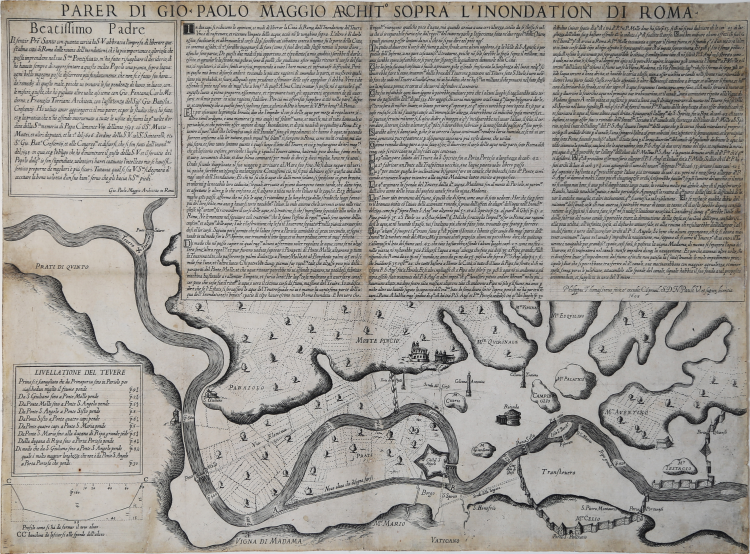



| Reference: | S43125 |
| Author | Philippe THOMASSIN |
| Year: | 1608 |
| Zone: | Tevere |
| Measures: | 521 x 387 mm |


| Reference: | S43125 |
| Author | Philippe THOMASSIN |
| Year: | 1608 |
| Zone: | Tevere |
| Measures: | 521 x 387 mm |
Rarissima tavola raffigurante il progetto dell’architetto milanese Giovanni Paolo Maggio di incanalare il fiume Tevere. Incisa e pubblicata a Roma dal francese Philip Thomassin nel 1608.
In qualità di architetto delle Chiane scrisse un «Breve discorso […] per evitare l’innondatione del Tevere alla città di Roma» ed altri interventi relativi a questo annoso problema. Nella «Proposta […] per rimediare all’inondazione del Tevere oltre alle resolutioni d’altri rimedi» (Biblioteca Apostolica Vaticana, Chigi H.II. 43, ff. 168 e ss) proponeva di creare un canale, nel quale far defluire parte delle acque del fiume, che avrebbe costruito con circa 39.000 scudi. La proposta fu illustrata due anni dopo in una incisione di Philippe Thomassin intitolata «Parer di Gio. Paolo Maggio arch. to sopra l’inondazion di Roma». (Cfr. Scavizzi, Fonti per uno studio sulla regolazione del Tevere dal Cinquecento al Settecento. Fra teoria e pratica, in «Archivio della Società Romana di Storia Patria», 102 (1979), pp. 273-313, in particolare pp. 246, 248, 309, tav. I.; M. M. Segarra Lagunes, Il Tevere e Roma: storia di una simbiosi, Roma 2004, in part. pp. 81, 121 (lo confonde talora con Giuseppe Maggi).
Bibliografia
Feltrinelli, Christie’s 1998, lot 1046; C. Paola Scavizzi, Fonti per uno studio sulla regolazione del Tevere dal Cinquecento al Settecento in “Archivio della Società romana di storia patria”, 102, 1979, n. 39; Maria Barbara Guerrieri Borsoi, Notizie biografiche sull’architetto Giovanni Paolo Maggi, in “Strenna dei Romanisti”, Natale 2018.
Philippe THOMASSIN (Troyes 1562 - Roma 1622)
|
Engraver and print publisher, from Troyes. Active in Rome from 1585 .
C.1589 he entered into a partnership with Jean Turpin; it was described in the dissolution agreement of 19 January 1602 as a society ‘for the practice of painting and engraving,for the purchase and sale of engraved works printed by them or on their orders,for retail and wholesale trading and the sending abroad of such works…’
In 1590 he was arrested and interrogated by the Holy Office on account of a portrait of Henry IV of France that he had engraved.
In his early years in Rome he worked for print publishers such as Claudio Duchetti, Lorenzo Vaccari and Marcello Clodio. In 1588 he began to publish his own work. He bought old plates, as for example the group acquired from the heirs of Aliprando Caprioli c.1599, for which he applied for a ten-years privilege from Clement VIII in that year. In 1603 he published two engravings by Villamena . Baglione said that he largely concentrated on religious subjects. But this was not exclusively the case, as is shown by important collections such as the Antiquarum Statuarum Urbis Romae.
|
Philippe THOMASSIN (Troyes 1562 - Roma 1622)
|
Engraver and print publisher, from Troyes. Active in Rome from 1585 .
C.1589 he entered into a partnership with Jean Turpin; it was described in the dissolution agreement of 19 January 1602 as a society ‘for the practice of painting and engraving,for the purchase and sale of engraved works printed by them or on their orders,for retail and wholesale trading and the sending abroad of such works…’
In 1590 he was arrested and interrogated by the Holy Office on account of a portrait of Henry IV of France that he had engraved.
In his early years in Rome he worked for print publishers such as Claudio Duchetti, Lorenzo Vaccari and Marcello Clodio. In 1588 he began to publish his own work. He bought old plates, as for example the group acquired from the heirs of Aliprando Caprioli c.1599, for which he applied for a ten-years privilege from Clement VIII in that year. In 1603 he published two engravings by Villamena . Baglione said that he largely concentrated on religious subjects. But this was not exclusively the case, as is shown by important collections such as the Antiquarum Statuarum Urbis Romae.
|